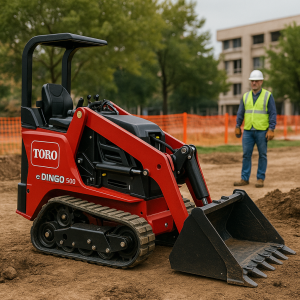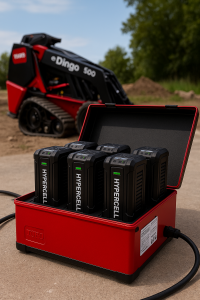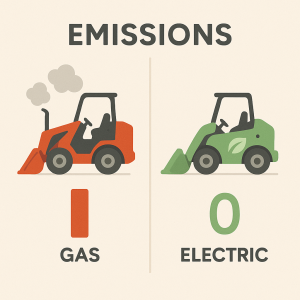Over the past two years, Toro has shaken up the compact‑equipment market with its HyperCell® battery platform, debuting machines such as the eDingo 500 and the eDingo TX 750. Designed for everything from interior demolition to material handling, these all‑electric loaders match—or even exceed—the muscle of their gas‑powered siblings while eliminating tailpipe emissions toro.com Compact Equipment Magazine. With oil‑ and exhaust‑free operation, jobsite managers are finding new ways to stay productive when noise ordinances or air‑quality rules make gas engines impractical.

Environmental and Sustainability Benefits (“Green Works”)
Electric machinery offers a clear “green” advantage. By swapping diesel or gasoline for lithium‑ion power, operations cut local emissions to zero and shrink carbon footprints—key in regulated urban zones or indoor sites. Toro’s units produce less than 80 dBA of noise, compared to the 95–105 dBA typical of small gas engines, keeping neighbourhoods and workplaces happier and in compliance with sound restrictions. toro.com. Meanwhile, fewer fluid changes and no catalytic converters mean less maintenance waste heading to the landfill.

Key Advantages of Toro’s Electric Models
-
All‑Day Runtime
-
Up to eight hours of continuous operation on a single charge, thanks to six 2.3 kWh HyperCell packs (13.5 kWh total) and onboard charging from any 120 V outlet Compact Equipment Magazine.
-
-
Zero Emissions & Quiet Operation
-
Clean‑air compliance for indoor or noise‑sensitive environments; sound levels more than 15 dBA below most gas loaders.
-
-
Lower Maintenance
-
No oil changes, no spark plugs, no air filters—just periodic inspections of the battery‑management system and cooling fan.
-
-
Compact Maneuverability
-
The eDingo 500 slips through a standard 3‑ft. door at just 30 in. wide; the TX 750 manages tight hallways with narrow tracks and one‑handed controls toro.comCompact Equipment Magazine.
-

Performance & Total Cost of Ownership
| Feature | Toro eDingo 500 (Electric) | Toro Dingo 2200 (Gas) |
|---|---|---|
| Rated Operating Capacity | 515 lb | 515 lb |
| Runtime Cost (8 h) | ~$2.03* | ~$32** |
| Maintenance Interval | Battery check every 250 h | Oil & filter every 50 h |
| Fuel/Charge Logistics | 120 V outlet; onboard charging | Bulk fuel storage, engine warm‑up |
*13.5 kWh × $0.15 / kWh; **1 gal/h @ $4/gal Compact Equipment Magazinetoro.com
Beyond lower hourly “fuel” costs (electricity averages 75–90 % cheaper than gasoline), electric loaders eliminate monthly oil and filter expenditures. Rental fleets see more uptime because machines spend less time in the shop, boosting utilization.
Competitor Comparison: Greenworks 80V String Trimmers
When it comes to handheld, battery‑powered tools in Canada, Greenworks’ 80 V lineup is a popular yardstick. Here’s how two of their string trimmers stack up against Toro’s cordless trimmer offerings:
-
Greenworks 80 V 16″ String Trimmer (ST80L211)
-
Runtime: up to 50 minutes (2.0 Ah battery)
-
Recharge Time: 30 minutes
-
Cutting Path: 16″ LOAD N’ GO™ bump feed
-
Motor: Brushless torque‑optimized
-
Warranty: 4‑year tool & battery Greenworks Tools
-
-
Greenworks 80 V 13″ TORQDRIVE™ Trimmer (GST80320)
-
Runtime: up to 66 minutes (2.0 Ah battery)
-
Recharge Time: 30 minutes
-
Cutting Path: 13″ dual‑line bump feed
-
Features: Variable‑speed trigger, 2‑speed selector
-
Warranty: 4‑year tool & battery Amazon
-
Toro’s 60 V Flex Force™ trimmer (4.0 Ah) delivers roughly 45 minutes per charge, with an AutoFeed™ head and two‑speed switch—offering a slightly wider 17″ swath but similar user controls.
Real‑World Use Cases
-
Municipal Projects
Electric loaders excel in parks or civic facilities where emissions are banned and noise is metered. Clean, quiet power also benefits interior renovations in schools and hospitals. -
Landscaping & Rental Fleets
Rental houses appreciate reduced downtime: no oil‑change queues, fast overnight charging, and simpler end‑of‑day checks. Landscapers can switch batteries between tools on a shared 60/80 V platform. -
General Construction
Trades like concrete cutting, tile removal, and debris hauling indoors see fewer coordination headaches, since crews can work around ongoing operations without triggering air‑quality alarms or disturbing occupants.
Limitations to Consider
-
Upfront Cost Premium
Electric units have a 15–25 % higher sticker price than gas units, though incentives and lower operating expenses narrow the gap over 1–2 years. -
Charging Infrastructure
Multiple machines need banked outlets or a portable charger cart for quick swap‑and‑go. Planning outlet access is critical on remote sites. -
Heavy‑Duty Demand
Extreme loads or continuous 24/7 shifts may still favor gas for instantaneous refuels, though fast‑swap battery packs are arriving soon.
Toro’s battery‑powered compact equipment has proven it can stand toe‑to‑toe with traditional gas models, especially where noise, emissions, and maintenance logistics are major concerns. For indoor demolition, urban landscaping, and rental fleets seeking greater uptime, the electric eDingo series and Ultra Buggies deliver all‑day runtime, simplified servicing, and dramatically lower “fuel” costs. Gas loaders still command an edge in unlimited refuelling and lower entry price, but as charging tech and battery economies advance, the scales are tipping toward electric on many job sites.


